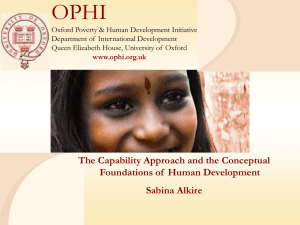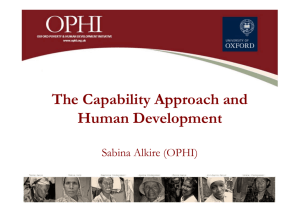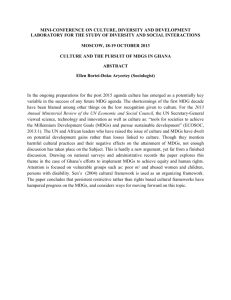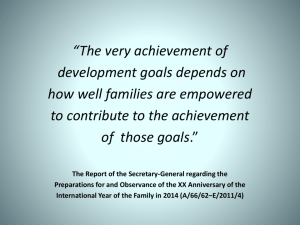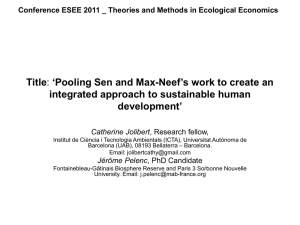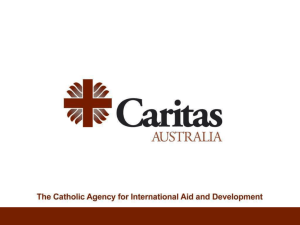Session 2a MD Poverty and CA Alkire 2010
advertisement
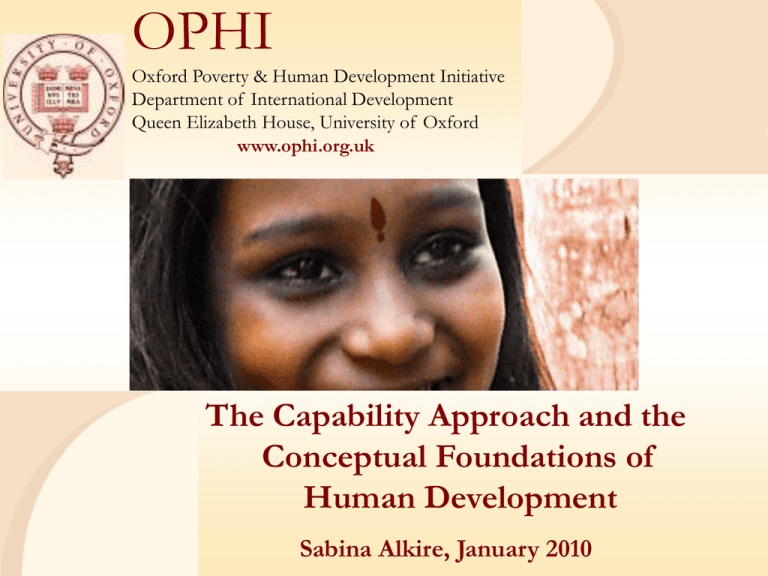
OPHI Oxford Poverty & Human Development Initiative Department of International Development Queen Elizabeth House, University of Oxford www.ophi.org.uk The Capability Approach and the Conceptual Foundations of Human Development Sabina Alkire, January 2010 Outline • Part I: The Capability Approach & HD – – – – History and Motivation Capabilities Functionings Agency • Part II: Complementary Initiatives – – – – Growth MDGs Human Rights, and Human security • Part III: Dimensions of HD Welfare Motivation – Atkinson notes that ‘despite the prevalence of welfare statements in economics, we are no longer subjecting them to critical analysis – ‘The welfare basis of policy evaluation is a topic which should receive greater priority in economics.’ ‘The Strange Disappearance of Welfare Economics’ 2001. (CA provides a partial basis for econ policy) Multidimensionality “There is widespread agreement that deprivation is multidimensioned. It is not enough to look only at income poverty; we have also to look at other attributes. As Sen has put it, “the role of income and wealth. . . has to be integrated into a broader and fuller picture of success and deprivation” – Atkinson, A.B. 2002 Multidimensionality • Bourguignon and Chakravarty 2003 also draw on the capability approach to justify their multidimensional approach to measurement: “Well-being is intrinsically multidimensional from the view point of ‘capabilities’ and ‘functionings.’” (2003 p 26) Intrinsic Value • Sen’s capability approach has been widely cited by economists and social scientists • Citations aside, the issues the capability approach raises seem arguably worth considering on their own merit Intellectual History of CA • 1979 – Sen ‘Equality of What’? • Basic Needs – same motivation but in some versions people are passive. CA adds freedom • 1980s – focused on growth as end; CA growth as means; needs to be complemented by HD / CA • 1990s to present: Annual Human Devt Reports • Key texts by Sen: – – – – – 1984: Commodities and Capabilities 1992: Inequality Re-Examined. 1993: Quality of Life (edited with Martha Nussbaum) 1999: Development as Freedom 2009: The Idea of Justice • Now a large group of other authors (Nussbaum et al) • Is this approach still relevant, or has it been superseded? Amartya Sen, key author Born 1933 in Dhaka, Bangladesh. Primary education in Tagore’s school in Santiniketan, India. Witnessed Bengal famine in which 2-3 million people died. Witnessed murder of a muslim day laborer in the times of partition Studied in Kolkata and Cambridge UK; taught in Delhi School of Economics, London School of Economics, Oxford, Cambridge and Harvard. Received Nobel prize 1998 Currently teaching at Harvard. What is the Capability Approach? • Sen’s capability approach is a moral framework. It proposes that social arrangements should be primarily evaluated according to the extent of freedom people have to promote or achieve functionings they value. • This is an Evaluative Approach. Capability • the various combinations of functionings (beings and doings) that the person can achieve. [It] is, thus, a set of vectors of functionings, reflecting the person’s freedom to lead one type of life or another...to choose from possible livings. (Inequality Re-examined) • think of it as a budget set • “The focus here is on the freedom that a person actually has to do this or be that – things that he or she may value doing or being.” Idea of Justice 232 • All formulations of capability have two parts: freedom and valuable beings and doings (functionings). Sen’s significant contribution has been to unite the two concepts. Functionings The various things a person may value and have reason to value doing or being - intuitive - intrinsically valuable to the person - intrisic value (have reason to value) - so avoids adaptive preferences - ‘doings and beings’ is our focal space Functionings allow for different interpersonal conversion factors Resources Capability Functionings Utility Bike Able to ride around Ride around Food Able to be nourished Nourished Indicators of Functionings Which are direct indicators of functionings? A. B. C. D. E. F. Asset index Access to a health clinic Body Mass Index Immunization Self-reported health Times per week consume egg Freedom • “the real opportunity that we have to accomplish what we value” • “The ‘good life’ is partly a life of genuine choice, and not one in which the person is forced into a particular life – however rich it might be in other respects.” It is authentic self-direction – the ability to shape one’s own destiny as a person and a part of various communities. Freedom is regularly misunderstood • Freedom is Not a ‘paper’ freedom: it has to be effective freedom, a real possiblity. • Freedom is Not maximization of choices without regard to their quality and people’s values “Indeed sometimes more freedom of choice can bemuse and befuddle, and make one’s life more wretched.” • Freedom is Not necessarily direct control by an individual , groups, states, etc can increase freedoms by public action and investment. Freedom for Sen, Freedom has two aspects Process Aspect: Ability to act on behalf of what matters (agency) Institutions, movements, democratic practice Opportunity Aspect: Real opportunity to achieve valued functionings, selected from among various good possibilities. (capability) Agency: Definition “what a person is free to do and achieve in pursuit of whatever goals or values he or she regards as important.” Sen “Well-being Agency and Freedom” J of Philosophy 1985: 203 “someone who acts and brings about change, and whose achievements can be judged in terms of her own values and objectives, whether or not we assess them in terms of some external criteria as well” Sen Development as Freedom. 1999: 19 agency is the person’s ability to act on what they value and have reason to value. Capabilities and Agency “The approach … is essentially a ‘people-centered’ approach, which puts human agency (rather than organizations such as markets or governments) at the centre of the stage. The crucial role of social opportunities is to expand the realm of human agency and freedom, both as an end in itself and as a means of further expansion of freedom. The word ‘social’ in the expression ‘social opportunity’ (…) is a useful reminder not to view individuals and their opportunities in isolated terms. The options that a person has depend greatly on relations with others and on what the state and other institutions do. We shall be particularly concerned with those opportunities that are strongly influenced by social circumstances and public policy…” (Drèze & Sen 2002 page 6). Other Process freedoms: Social Movements, Advocacy, Democratic Practice, Responsibility “The fact that so many people … go on perishing from persistent deprivation on a regular basis, is a calamity to which the world has, somewhat incredibly, got coolly accustomed. It does not seem to engender the kind of shock and disquiet that might be reasonable to expect given the enormity of the tragedy. Indeed, the subject often generates either cynicism (‘not a lot can be done about it’) or complacent irresponsibility (‘don’t blame me – it is not a problem for which I am answerable’). What is lacking is constructive impatience and public outcry Engaged Research – virtuous circle for research quality ‘the value of scientific research can, in many circumstances, be enhanced even further if it is combined with real world involvement and action.’ Jean Drèze ‘02 How does the Capability Approach Relate to Human Development • Human Development is conceptually founded on the capability approach, and looks to application. • HD used Sen’s phrase – that the objective of development is to expand capabilities – and simplified it to “expand people’s choices.” • The language has changed; the objective has not. • Whereas there are significant conceptual differences between HD and HR, HS, MDGs, there are not significant differences with the CA. Objective of Development “Development can be seen…as a process of expanding the real freedoms that people enjoy.” Opening Sentence, Development as Freedom The goal of development is the “promotion and expansion of valuable capabilities.” Sen, “Development as Capability Expansion” People are the real wealth of nations. Indeed, the basic purpose of development is to enlarge human freedoms. The process of development can expand human capabilities by expanding the choices that people have to live full and creative lives. And people are both the beneficiaries of such development and the agents of the progress and change that bring it about. This process must benefit all individuals equitably and build on the participation of each of them. This approach to development—human development—has been advocated by every Human Development Report since the first in 1990. HDR 2004 p 127 Common Misunderstandings • Breadth – well beyond health & education • Individualism (is ethical not methodological) • Evaluative vs Prospective analysis. It can evaluate activities, or guide policy to create choices. • It is deliberately incomplete – it has to be operationalized differently in different contexts. • Not all multidimensional analyses are capability analyses – many don’t consider freedom/agency, intrinsic values, space of capabilities not resources, agency, and the process of public debate etc. Part II What does Human Development mean in terms of other objectives that guide development? –Growth –MDGs –Human Rights –Human Security Why Growth? Is a high GDP/ capita needed for HD? Saudi Arabia Uruguay Russia Costa Rica Vietnam Morocco GDP per capita (PPPUS$) 15,711 9,962 10,845 9,481 3,071 4,555 Adult literacy rate (%) 82.9 96.8 99.4 94.9 90.3 52.3 Female literacy rate (%) 76.3 97.3 99.2 95.1 86.9 39.6 Life expectancy (years) 72.2 75.9 65 78.5 73.7 70.4 Under 5 mortality (0/00) 26 15 18 12 19 40 Political Rights/Civil Libertiesa 7/6 1/1 6/5 1/1 7/5 5/4 Human Development Index 0.812 0.852 0.802 0.846 0.733 0.646 Source: Human Development Report 2007/2008, see www.undp.org a Freedom House 2008 (with 1 being most free and 7 less free), see www.freedomhouse.org Not necessarily. HDI does not always match income per capita. Do incomes mean better HD Not income poor Income Poor Non-deprived in non-monetary dimension Deprived in nonmonetary dimension Group A Group B (I) Group C (II) Group D Ruggieri-Laderchi 2007 If monetary poverty is used for policy & targetting: Group B represents a targeting error I (omission of some poor) Group C represents a targeting error II (inclusion of non-poor) High percentages of people are in B&C B (omission) C (overcount) Big Numbers! Conclusion: Income significantly mis-identifies people’s deprivations at individual level. Supplemental Direct Measures are necessary for policy & targetting. Ruggieri-Laderchi, Saith and Stewart ’03, ‘07 But even if income is an inadequate measure, perhaps growth is an adequate objective? This is a lively topic in 2008 – DFID etc. India: 15 years of strong economic growth. 1998-9 NHFS-2: 47% children < 3 are undernourished 2005-6 NHFS-3: 46% (FOCUS 06) (wt-age) In 1998/9, 58% of children < 3 yrs had not completed vaccinations; by 2005/6 still 56% of children were not fully vaccinated. And anaemia rose 75%-79% in those years. Growth Commission Report 2008 Cases: 7+% growth, over 25+ years ‘Successes’ include some strong HD performers. But - In Indonesia 28% of children <5 are underweight and 42% are stunted - In Botswana, 30% of the population are malnourished, LE has fallen 20 years to 44 years, HDI rank is 70 places below the GDP rank. - In Oman, women earn significantly less than 20% of male earnings Conclusion: Top economic growth does not automatically advance HD; other goals must be pursued explicitly at the same time. Haq 1995 “It is the lack of political courage to make tough decisions, rather than the paucity of financial resources, that is responsible for the current state of human neglect.” Human Development and the Milennium Development Goals A conceptual exploration “We will spare no effort to free our fellow men, women, and children, from the abject and dehumanizing conditions of extreme poverty, to which more than a billion of them are now subjected.” Kofi Annan If we met the MDGs would we have HD? (1) Eradicate extreme hunger and poverty. (2) Achieve universal primary education. (3) Promote gender equality and empower women. (4) Reduce child mortality by two-thirds. (5) Reduce maternal mortality by three-quarters. (6) Combat HIV/AIDS, malaria, and other diseases. (7) Ensure environmental sustainability. (8) Develop a global partnership for development. 1. Are the MDGs focused on functionings /capabilities? Eradicate extreme hunger and poverty. (2) Achieve universal primary education. (3) Promote gender equality and empower women. (4) Reduce child mortality by two-thirds. (5) Reduce maternal mortality by three-quarters. (6) Combat HIV/AIDS, malaria, and other diseases. (7) Ensure environmental sustainability. (8) Develop a global partnership for development. (1) 1. Are the MDGs focused on functionings /capabilities? (1) (2) (3) (4) (5) (6) (7) Eradicate extreme hunger and poverty. Hunger – yes; $1/day - indirectly Achieve universal primary education. Indirectly – if schooling creates knowl. Promote gender equality and empower women. Yes. Reduce child mortality by two-thirds. Yes. Reduce maternal mortality by three-quarters. Yes. Combat HIV/AIDS, malaria, and other diseases. Yes. Ensure environmental sustainability. These are resources – tho vital ones. (8) Develop a global partnership for development. Indirectly. 1. Are the MDGs focused on functionings /capabilities? Do their indicators adequately represent their focus? (1) (2) (3) (4) (5) (6) (7) Eradicate extreme hunger and poverty. Hunger –U5m, calories; $1/day, Achieve universal primary education. Indirectly – if schooling creates knowl. Promote gender equality and empower women. Yes +. Reduce child mortality by two-thirds. Yes. Reduce maternal mortality by three-quarters. Yes. Combat HIV/AIDS, malaria, and other diseases. Yes. Ensure environmental sustainability. These are resources – tho vital ones. (8) Develop a global partnership for development. Indirectly. Most MDGs are directly focused on functionings; although the indicators for some are resources. 2. If we meet the MDGs will capabilities have expanded? (1) (2) (3) (4) (5) (6) (7) Eradicate extreme hunger and poverty. Achieve universal primary education. Promote gender equality and empower women. Reduce child mortality by two-thirds. Reduce maternal mortality by three-quarters. Combat HIV/AIDS, malaria, and other diseases. Ensure environmental sustainability. (8) Develop a global partnership for development. 1. Do people value the functionings the MDGs deliver? 2. Are they coerced into enjoying them or do they act as agents? 3. Do other valuable options shrink? If so does this outweight MDG progress? 2. Does progress towards MDGs expand capabilities? (in other words, in what cases can we say that an expansion of basic functionings IS an expansion of capabilities?) If the following conditions are met, MDGs expand capabilities: • People value the functionings the MDGs deliver. • People are not coerced; they participate as agents. • Other valuable options do not shrink so much as to outweigh MDG progress. Alas technically the MDGs could also be met in prison. MDGs and HD: MDGs HD Fixed in number Fixed in time Fixed internationally Developing ctries Focused on poor Needs political will Omits participation Omits Human Rts Concrete LT Political focus Open-ended Enduring Needs periodic debate All countries Includes all people* Needs political will Requires participation Complements HR req LT concrete goals * With priority for poor HD needed something like national MDGs to catalyze public action (Haq 1995) The human dimension in development planning: 1. Plans would begin with a human balance sheet - human resources, skills, income dist, unemployment, urban/rural, “What are the cultural and social attitudes and aspirations of the people?... how does the society live and breathe?” 5 2. “all plans will not look the same. They will carry the flesh and colour of their people and their societies.” 6 3. Plans integrate production and distribution objectives 4. Decentralized strategy, with participation & self-reliance. 5. Performance analysed against social & human indicators. Human Development and Human Rights A conceptual exploration This insistence on a claim on others takes us beyond the idea of human development. HDR 2000 HR and HD: HR HD Moral/Normative MD - Universal Decl Fixed in time Fixed internationally Specifies obligations Independent All top priority Moral/Normative MD - Open-ended Flexible, contextual Needs periodic debate Seeks expansions Studies interactions Can sequence, prior. Resp, Culp, Account Legal Institutions, norms not specified. Other institutions. Human Development and Human Security A conceptual exploration The Concept of Human Security: to protect the vital core of all human lives in ways that enhance human freedoms and human fulfilment. HS Now 03 Human security means protecting fundamental freedoms—freedoms that are the essence of life. It means protecting people from critical (severe) and pervasive (widespread) threats and situations. It means using processes that build on people’s strengths and aspirations. It means creating political, social, environmental, economic, military and cultural systems that together give people the building blocks of survival, livelihood and dignity. The Concept of Human Security • people-centred • freedom from fear and freedom from want. • focused in scope to critical pervasive threats • attends to downside risks to human lives But many alternatives, 40+ definitions… eg Human security report = Violence only; HDR 94, quite wide-ranging The Process of Human Security Protection People Empowerment Human Security and State Security (Like Human Development and Economic Development) Similarities: Both are focused in scope Both prepare for worst case scenarios Both are multidisciplinary and multidimensional Differences: The Unit of Analysis shifts to the human being not the nation. The focal dimensions widen beyond territorial aggression, to include economic, social, political, and military security. Clear emphasis on empowerment as well as on protection. HS and HD HS HD Vital core of freedoms Protect from threat/risk Participation Protection Multidimensional All countries Includes all people* Needs political will People not territory All freedoms Expand Agency & Participation Many roles/institutns. Multidimensional All countries Includes all people* Needs political will People not economy * With priority for poor In sum: ideas matter Sen: ‘a misconceived theory can kill’ – Growth – focus on efficiency, general purpose means [omit direct interventions, public action, ends] – MDGs – integrated, multiple, measurable, engage LT collective action [but limited, omit freedom to choose dimension, omit agency and empowerment] – Human Rts – multiple, normative [trade-offs? empirical work? Guide economic policy? Processes?] – Happiness – unidimensional, perceptual [reflection of objective reality? Adaptive preferences? Agency?] – As an enduring ethical framework, the Capability Approach can critically assess, strengthen and complete existing frameworks, thus influence the frontiers & the direction of change. Haq 1995 “It is fair to say that the human development paradigm is the most holistic development model that exists today. It embraces every development issue, including economic growth, social investment, people’s empowerment, provision of basic needs and social safety nets, political and cultural freedoms and all other aspects of people’s lives. It is neither narrowly technocratic nor overly philosophical. It is a practical reflection of life itself.” p 23 Part III: Choosing Domains • Grusky and Kanbur acknowledge the consensus that the multidimensionality of poverty and inequality should not be treated as soft social issues that can be “subordinated to more important and fundamental interested in maximizing total economic output.” • But they regard the choice of dimensions as a ‘pressing conceptual question.’ “economists have not reached consensus on the dimensions that matter, nor even on how they might decide what matters.” How Researchers Choose Dimensions Existing Data or Convention Theory Public ‘consensus’ Ongoing Deliberative Participatory Processes • Empirical Evidence regarding people’s values • • • • How Researchers Choose Dimensions • Existing Data or Convention – select dimensions (or capabilities) mostly because of convenience or a convention that is taken to be authoritative, or because these are the only data available that have the required characteristics. How Researchers Choose Dimensions • Theory – select dimensions based on implicit or explicit assumptions about what people do value or should value. These are commonly the informed guesses of the researcher; they may also draw on convention, social or psychological theory, philosophy, religion, and so on. How Researchers Choose Dimensions • Public ‘consensus’ – select dimensions that relate to a list that has achieved a degree of legitimacy due to public consensus. Examples at the international level are universal human rights, the MDGs, and the Sphere project; these will vary at the national and local levels. How Researchers Choose Dimensions • Ongoing Deliberative Participatory Processes – select dimensions on the basis of ongoing purposive participatory exercises that periodically elicit the values and perspectives of stakeholders. How Researchers Choose Dimensions • Empirical Evidence regarding people’s values – select dimensions on the basis of empirical data on values, or data on consumer preferences and behaviors, or studies of which values are most conducive to mental health or social benefit. CA requires a combination of participation and objectivity Existing Data or Convention Theory (in part – not alone) Public ‘consensus’ Ongoing Deliberative Participatory Processes • Empirical Evidence regarding people’s values • • • • Sen’s Criteria for Dimensions • Purpose of the Evaluation (targeting, monitoring, measure quality of life, sectoral) • Value and priority [for relevant group(s)] – basic importance (Sen 2004) • Appropriateness for institutional response – social influenceability (Sen 2004) – (see Alkire 2008 Choosing Dimensions) Procedural justification of domains (Robeyns) • 1. Explicit formulation: the list [of domains and/or capabilities] should be made explicit, discussed and defended in any multidimensional poverty measure that is developed and advocated for policy reflections: why it is claimed to be something people value and have reason to value. • 2. Methodological justification: The method that has generated the list should be clarified and defended (and open to critique or modification). For example, whether this domain was chosen on the basis of a participatory exercise, or through consultation of empirical studies of human values. • 3. Two stage process: Ideal-Feasible : Only from the second stage onwards will constraints and limitations related to the measurement design and data collection, or to political or socio-economic feasibility in the case of policy-oriented applications, be taken into account. • 4. Exhaustion and non-reduction: the capabilities on the [ideal] list should include all elements that are important: no dimensions that are relevant should be left out. For example, those capabilities related to the non-market economy should also be included in economic assessments. Some Sample lists for different purposes Finnis 1987: Basic Human Values Sen 1999: Instrumental Freedoms Human Flourishing Bodily life – health reprod and safety Knowledge & skills Meaningful work and play Relations / Friend Agency, Participation (Practical reason) Self-integration Harmony with ultimate source(s) of reality (Faith, Nature, Art) political freedom economic facilities social opportunities transparency guarantees protective security Nussbaum 1998: Central Human Capabilities Life Bodily health Bodily integrity Senses, thought imagination, Emotions Practical reason Affiliation Other species Play Control over one’s environment Rawls 1993: Political Liberalism The basic liberties freedom of movement, freedom of association freedom of occupational choice against a background of diverse opportunities powers and prerogatives of office positions of responsibility in political and economic institutions income and wealth the social bases of self respect Doyal & Gough 1992: Intermediate Needs Nutritional food/water Protective housing Work Physical environment Health care Security in childhood Significant primary relationships Physical security Economic security Safe birth control/ childbearing Basic education
